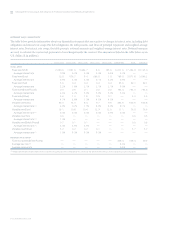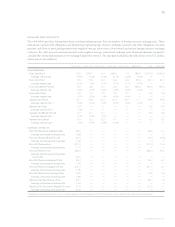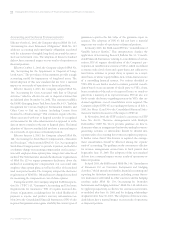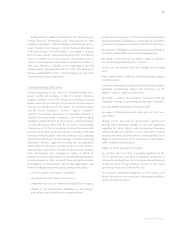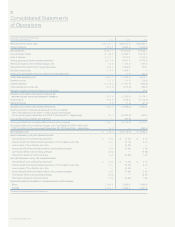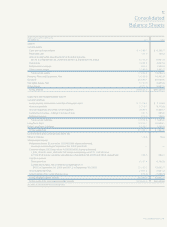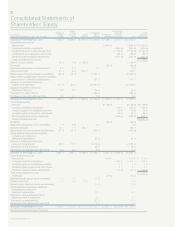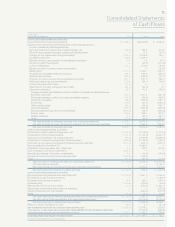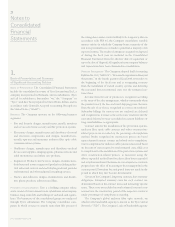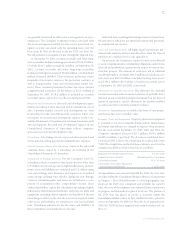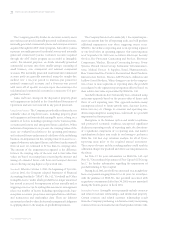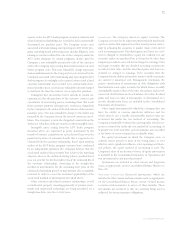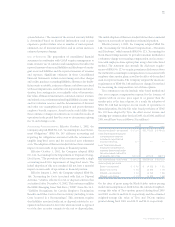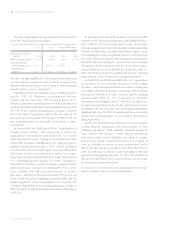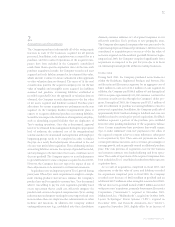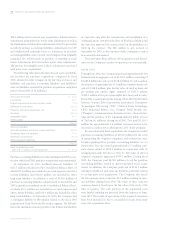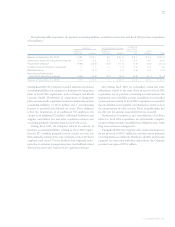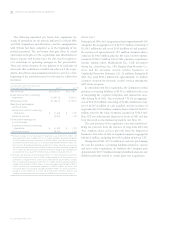ADT 2003 Annual Report Download - page 74
Download and view the complete annual report
Please find page 74 of the 2003 ADT annual report below. You can navigate through the pages in the report by either clicking on the pages listed below, or by using the keyword search tool below to find specific information within the annual report.
72
The Company generally divides its electronic security assets
into various asset pools: internally generated residential systems,
internally generated commercial systems and customer accounts
acquired through the ADT dealer program. Subscriber systems
represent internally generated residential systems and internally
generated commercial systems (customer accounts acquired
through the ADT dealer program are recorded as intangible
assets). For internal purposes, we divide internally generated
commercial accounts into three smaller groups consisting of
small business, core commercial and national commercial
accounts. The internally generated residential and commercial
account pools are generally amortized using the straight-line
method over a ten-year period (a fourteen-year period for
national commercial accounts and a fourteen-year period
with write off of specific accounts upon discontinuance for
residential and commercial accounts in certain non-U.S. geo-
graphic locations).
Gains and losses arising on the disposal of property, plant
and equipment are included in the Consolidated Statements of
Operations and were not material in any period presented.
Long-Lived Assets The Company periodically evaluates the net
realizable value of long-lived assets, including property, plant
and equipment and amortizable intangible assets, relying on a
number of factors including operating results, business plans,
economic projections and anticipated future cash flows. When
indicators of impairment are present, the carrying values of the
assets are evaluated in relation to the operating performance
and estimated future undiscounted cash flows of the underlying
business. An impairment in the carrying value of an asset is rec-
ognized whenever anticipated future cash flows (undiscounted)
from an asset are estimated to be less than its carrying value.
The amount of the impairment recognized is the difference
between the carrying value of the asset and its fair value. Fair
values are based on assumptions concerning the amount and
timing of estimated future cash flows and assumed discount
rates, reflecting varying degrees of perceived risk.
Goodwill Effective October 1, 2001, the beginning of Tyco’s fis-
cal year 2002, the Company adopted Statement of Financial
Accounting Standards (“SFAS”) No. 142, “Goodwill and Other
Intangible Assets,” under which goodwill is no longer amortized
but instead is assessed for impairment at least annually and as
triggering events occur. In making this assessment, management
relies on a number of factors including operating results, busi-
ness plans, economic projections, anticipated future cash flows,
and transactions and marketplace data. There are inherent
uncertainties related to these factors and management’s judgment
in applying them to the analysis of goodwill impairment.
The Company has elected to make July 1 the annual impair-
ment assessment date for all reporting units, and will perform
additional impairment tests when triggering events occur.
SFAS No. 142 defines a reporting unit as an operating segment
or one level below an operating segment. Our reporting units
as of September 30, 2003 were as follows: Electronic Security
Services, Fire Protection Contracting and Services, Electronic
Components, Wireless, Electrical Contracting Services, Power
Systems, Printed Circuit Group, Submarine Telecommunica-
tions, Medical Devices & Supplies, Retail, Pharmaceuticals,
Flow Control and Fire Products, Electrical and Metal Products,
Infrastructure Services, Plastics, A&E Products, Adhesives and
Ludlow Coated Products. When changes occur in the composi-
tion of one or more segments or reporting units, the goodwill
is reassigned to the segments/reporting units affected based on
their relative fair value as prescribed by SFAS No. 142.
Goodwill valuations have historically been calculated using
an income approach based on the present value of future cash
flows of each reporting unit. This approach includes many
assumptions related to future growth rates, discount factors,
future tax rates, etc. Changes in economic and operating con-
ditions impacting these assumptions could result in a goodwill
impairment in future periods.
Disruptions to the business such as end market conditions
and protracted economic weakness, unexpected significant
declines in operating results of reporting units, the divestiture
of a significant component of a reporting unit, and market
capitalization declines may result in our having to perform a
SFAS No. 142 first step valuation analysis for all of Tyco’s
reporting units prior to the required annual assessment.
These types of events and the resulting analysis could result in
additional charges for goodwill and other asset impairments in
the future.
See Note 17 for more information on SFAS No. 142, and
Note 11,“Discontinued Operations of Tyco Capital (CIT Group
Inc.),” for further information regarding the impairment of
goodwill relating to Tyco Capital.
During fiscal 2001, goodwill was amortized on a straight-line
basis over periods ranging from 10 to 40 years. In accordance
with the guidance of SFAS No. 142, goodwill associated with
acquisitions consummated after June 30, 2001 was not amortized
during the fourth quarter of fiscal 2001.
Intangible Assets Intangible assets primarily include contracts
and related customer relationships, and intellectual property.
Certain contracts and related customer relationships result
from the Company purchasing residential security monitoring
contracts from an external network of independent dealers who
TYCO INTERNATIONAL LTD.
Notes to Consolidated Financial Statements


